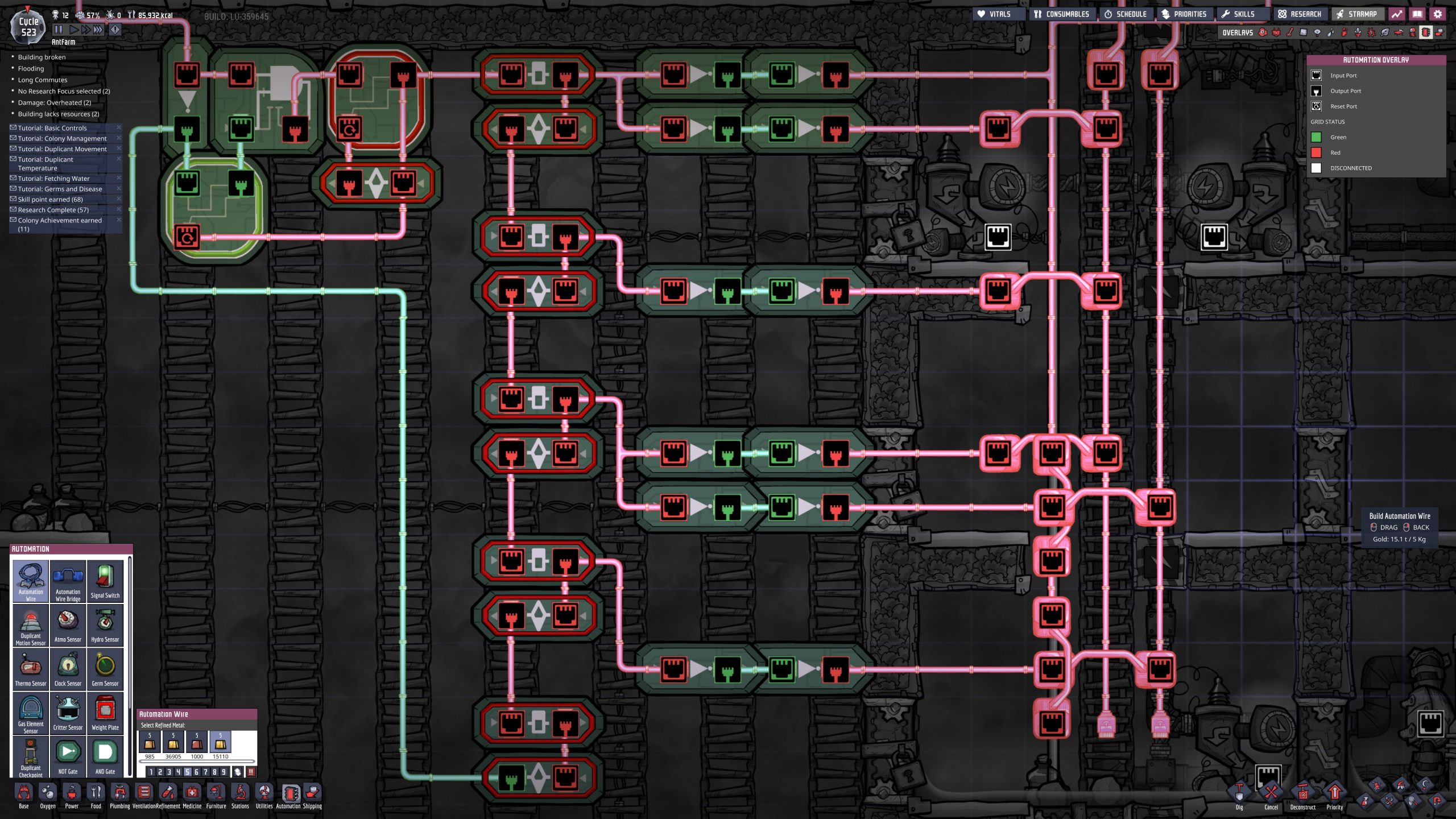Overview
Method to use automation to sequence doors to make infinite gas storage possible, profitable and easy.
How to Store Infinite Gas
This is done by sequencing automatic doors.
This is the sequence to move the gas from the deployment area to the storage area.
GAS DEPLOYMENT AREA — > GAS STORAGE
—————— —————– ||||||||||||||||||| – Gas floods into the 2 open doors
|||||||||||||||||||||| —————— |||||||||||||||||| – First door closes, trapping the gas inside
||||||||||||||||||||| ——————- ————— – Gas storage area is opened
|||||||||||||||||||| |||||||||||||||||||||||| ————— – Gas forced into storage area 1
|||||||||||||||||||| |||||||||||||||||||||||||| ||||||||||||||||| – Gas forced into storage area 2
This method is guaranteed not to let any gas escape from storage area.
Circuitry to do it is here for your base control circuitry area :
2 Parts to the circuit – left part makes a single pulse when the input goes high to start the cycle. ONI circuitry has an intrinsic clock of 10Hz. It is desirable that the circuit is in control at all times so timings are important. This pulse is 1 cycle(0.1s) exactly.
The right part is the set of control blocks. The first Control block(topmost) the Filter gate should be 1 cycle(0.1s) less than the buffer gate to compensate for the pulse time(as above stated)(timing can be any value of choosing, for example 1.0 and 0.9 for filter).
The subsequent control blocks can have any time as desired, both should be same time. This circuit type aught be able to generate any sequence on an arbitrary number of control signals and may be extended indefinitely.
The last one, the filter gate aught to be 0.3s(3 cycles) less than the buffer gate as the pulse control logic(the part on the left) takes 3 cycles to actuate. This way control is always maintained and there is no time when the control lines are in an indeterminate state.
*** Important Note ***
If using this circuit type to store gas, an unfortunate set of events may occur if power is lost, causing gas to be destroyed, for example gate sequence ||| |– |-| ||| will destroy gas permanently.
This may even be desirable in certain situations. However, to avoid this happening outwith design intentions, I strongly recommend having a smart battery logic somewhere that shuts the main circuit off gracefully if power drops too low.
And for the actual doors and control :
And here is me storing 300KG+ per tile of CO2 :
I will not elaborate on the design further; those of the correct order of intelligence aught to make use of it and make similar or superior design of their own from diagrams provided.
If ye mortals show interest, I may share more of my designs upon a day.
Gavin786
Update: More Experience and Wiser
I see a lot of people are using this guide, so I thought I would update it with what I have found out.
I have been doing a lot of experiments in moving gas and liquids around and here is what I have come up with so far.
Basically there are certain criteria for moving gas around with doors :
+ Speed
+ Can it create a vacuum
– Does it allow backflow
– Does it destroy gas in some circumstances
I have found some designs that fulfil this criteria.
Firstly, is a copy of the design that I created with the ladder logic*.
Much Simpler.
This + Can Create a Vaccum, + Does Not allow Backflow, and + Does not destroy gas. It is slow, however. Timings on it can be optimized, which I will update the guide later once I have got better timings, this should stand on its own tho, as its identical to the one above.
Here is a design with 4 doors which is also faster, and also fulfils the rest of the criteria :


It needs to be 3 tiles thick or pressure damage will destroy the walls. I am using sandstone tiles here. Pressure > 100000 kg/tile here.
* I have added the updated method I am using to create ladder logic below + the initialiser which is free of restart errors causing failure(you can switch it on and off while running and it wont mess up the system). This is a lot easier to understand as there is not such a tangle of wires. This is really great to test out/create any sequence before creating specialised logic to do it(like above). This is field-programmable and should be easier to see what is going on. If you are ever going to use this, please remember to respect the timings of the first and last block.








